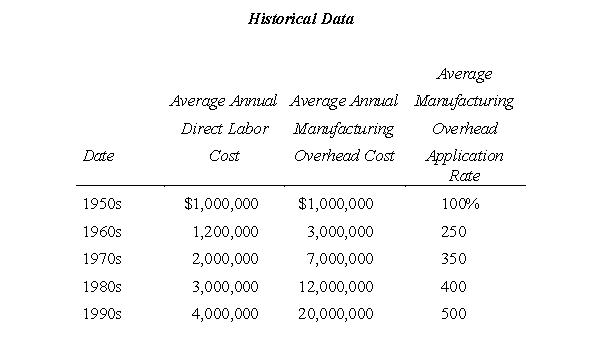Plantwide vs. Department Overhead Rates
Rose Bach has recently been hired as controller of Empco Inc., a sheet-metal manufacturer. Empco has been in the sheet-metal business for many years and is currently investigating ways to modernize its manufacturing process. At the first staff meeting Bach attended, Bob Kelley, chief engineer, presented a proposal for automating the drilling department. Kelley recommended that Empco purchase two robots that could replace the eight direct labor workers in the department. The cost savings outlined in Kelley's proposal include two elements. First, direct labor cost in the drilling department is eliminated. Second, manufacturing overhead cost in the department is reduced to zero because Empco charges manufacturing overhead on the basis of direct labor dollars using a plantwide rate.
The president of Empco felt that Kelley's explanation of the cost savings made no sense. Bach agreed and explained that as firms become more automated, they should rethink their manufacturing overhead systems. The president asked Bach to look into the matter and prepare a report for the next staff meeting.
To refresh her knowledge, Bach reviewed articles on manufacturing overhead allocation for an automated factory and discussed the matter with some of her peers. She also gathered the historical data presented below on the manufacturing overhead rates experienced by Empco over the years. Bach also wanted to have some departmental data to present at the meeting. Using Empco's accounting records, she was able to estimate the annual averages presented below for each manufacturing department in the 1990s. 
 Required:
Required:
a. Disregarding the proposed use of robots in the drilling department, describe the shortcomings of Empco's current system for applying overhead.
b. Do you agree with Bob Kelley's statement that the manufacturing overhead cost in the drilling department will be reduced to zero if the automation proposal is implemented? Explain.
c. Recommend ways to improve Empco's method for applying overhead by describing how it should revise its overhead accounting system:
(i) in the cutting and grinding departments.
(ii) to accommodate the automation of the drilling department.
Source: CMA adapted.
Correct Answer:
Verified
View Answer
Unlock this answer now
Get Access to more Verified Answers free of charge
Q1: Overhead Variances
Overhead is applied on the basis
Q1: Variable and Absorption Costing
Varilux manufactures a single
Q3: Basic Overhead Variances
Derf Company applies overhead on
Q4: Absorption Costing in a Bank
First Eastern Bank
Q6: Describe ABC
Required:
a. What is activity-based costing and
Q6: Developing Standards
ColdKing Company is a small producer
Q20: Expected, Standard, and Actual Labor Hours
The Pizza
Q45: ABC and Average Cost in a Service
Q52: Developing Additional Variances for Performance Evaluation
Maidwell Company
Q53: Standard Labor Variances
A CPA firm estimates that
Unlock this Answer For Free Now!
View this answer and more for free by performing one of the following actions

Scan the QR code to install the App and get 2 free unlocks

Unlock quizzes for free by uploading documents